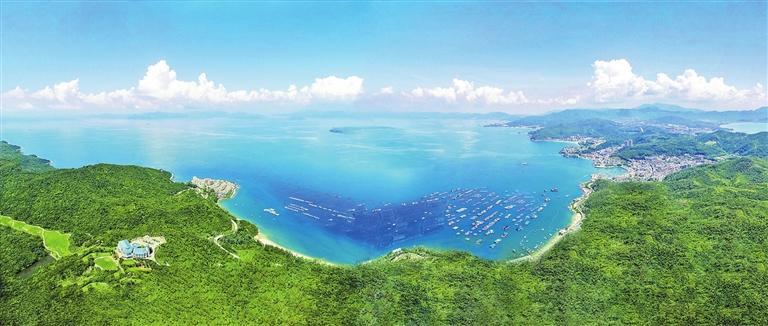

The Guangdong-Hong Kong-Macao Greater Bay Area’s drive to enhance its international tourism competitiveness has taken a decisive step forward with the launch of the 2-billion-yuan (US$276.4 million) Longqi Bay Integrated Resort project in Dapeng New District.
On May 7, China Travel-Senbo (Shenzhen) Tourism Resort Co. Ltd. — a joint venture between China Travel International Investment Hong Kong Ltd. and Hangzhou New Century Senbo Tourism Investment Co. Ltd. — secured the G16606-0122 plot in Dapeng’s Shuitou area for 146 million yuan, formalizing the resort’s landing in the district.

An aerial view of Dapeng's coastal area. File photos
The project is Dapeng’s first major cultural and tourism initiative since a municipal tourism acceleration conference was held. It also marks China Travel Group’s return to Shenzhen after three decades, joining the group’s previous landmark projects like Window of the World and Splendid China.
As the region’s first high-end, family-oriented, coastal eco-resort, the project is expected to reshape the city’s tourism landscape, deliver substantial socio-economic returns, and provide a replicable model for future development in the region.
Mixed-use, high-capacity model
The Dapeng resort represents the first joint venture between the two operators in southern China and will serve as a flagship site for their cooperation. The mixed-use project will integrate accommodations, leisure, wellness, education, and entertainment, catering to both families and young people.
The two parent companies bring complementary strengths to China Travel-Senbo. China Travel Group operates at over 50 scenic areas globally and serves 30 million visitors annually.

A computer-generated image of the future Longqi Bay Integrated Resort.
New Century Senbo, a subsidiary of New Century Hotel Group, has pioneered the “resort + themed accommodation + family park” model in Zhejiang, Yunnan, and Shandong provinces. Its 2019 flagship destination in Hangzhou generated more than 200 million yuan in revenue during its first year of operations and created knock-on effects for surrounding hotels and restaurants.
“Shenzhen’s east coast offers an ideal climate, rich natural resources, and cultural depth. The alignment between Dapeng’s ecological conditions and New Century Senbo’s brand ethos creates strong potential for national and international appeal,” said Wei Renlong, CFO of China Travel-Senbo.
He further added that the resort is projected to attract approximately 500,000 visitors in its first year, generate 19.88 billion yuan in revenue for related industries, directly create around 1,550 jobs, and indirectly create approximately 10,000 employment opportunities.
Tourism ecosystem
The resort will join the ranks of Dapeng’s broader tourism ecosystem, which includes Dapeng Fortress, the Legoland complex, eco-tourism trails, and marine sports hubs, facilitating cross-attraction mobility and extended stays in the area.
The site is designated as a heavy-capital anchor project under Dapeng’s broader High-Quality Tourism Development Three-Year Action Plan (2024–2026).
The resort is expected to function as a magnet for further investment in hospitality, retail, and support services, reinforcing Dapeng’s role as a high-end destination within the Greater Bay Area.
Regional transport, urban integration
Dapeng’s is striving to become China’s premier coastal holiday destination and an alternative to overseas travel for domestic tourists. With its dual ecological and cultural strengths — including China’s first International Dark Sky Community, the nation’s first Slow City, and consistent top rankings in air and environmental quality — the district is quickly becoming an asset in China’s tourism sector.
The project coincides with major transportation projects designed to integrate Dapeng with the broader Shenzhen metropolitan area. By 2025, the area will be connected via three new rail lines.
Metro Line 8 (Phase III), which is scheduled to open by the end of this year, will connect Dapeng to Luohu and Futian districts. The Shenzhen–Huizhou Intercity Rail (Dapeng Spur), which is expected to open by 2026, will link the district to regional economic corridors. Lastly, Metro Line 32 (Phase I), expected to start operations by 2028, will further improve access.
Other related infrastructure projects include new coastal highways, upgraded port terminals, and waterway routes to Hong Kong’s northeastern islands. As a whole, these projects aim to cut the travel time between Dapeng and the Futian CBD, the Bao’an airport, and Hong Kong to 50 minutes each.
Additionally, Dapeng is accelerating the implementation of major initiatives that target market influence, product supply capacity, brand appeal, industrial competitiveness, and service support.
The goal of these major initiatives is to achieve breakthroughs in 10 key areas, including building a world-class themed entertainment cluster.
Through new products, models, formats, and services, Dapeng aims to create new tourism trends, unleash its development potential, and accelerate its transformation into a world-class urban destination that is livable, business-friendly, and travel-ready.